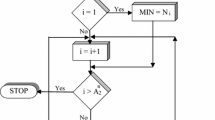Abstract
There are two aspects to cell formation in flexible manufacturing systems, cell sizing or deciding on the optimum number of machines to be allocated to each cell, and then allocation of specific machines to each cell. Although the latter problem has been investigated extensively there is a paucity of published work on the former. This paper discusses the effects of cell sizing on operational flexibility.
Operational flexibility is that aspect of flexibility that enables manufacturing systems to respond with speed and efficiency to changes in the manufacturing environment while maintaining an effective level of control.
Similar content being viewed by others
References
T. J. Greene and R. P. Sadowski, “Cellular manufacturing control”Journal of Manufacturing Systems,2(2), pp. 137–145, 1983.
H. C. Co and A. Araar, “Configuring cellular manufacturing systems”,International Journal of Production Research,26(9), pp. 1511–1522, 1988.
J. Browne, D. Dubois, K. Ratmill, S. P. Sethi and K. E. Stecke, “Classification of flexible manufacturing systems”,The FMS Magazine, pp. 114–117, April 1984.
C. Kim, “Issues on manufacturing flexibility”,Integrated Manufacturing Systems,2(2), pp. 4–13, 1991.
R. Suri and C. K. Whitney, “Decision support requirements in flexible manufacturing”,Journal of Manufacturing Systems,3(1), pp. 61–70, 1984.
H. A. Scott, R. P. Davis, R. W. Wysk and C. E. Nunnally, “Hierarchical control model for automated manufacturing systems”,Computers and Industrial Engineering,7(3), pp. 241–255, 1983.
F. Caputo, “Some problems in design of flexible manufacturing systems”,Annals of CIRP,32(1), pp. 417–421, 1983.
A. T. Jones and C. R. McLean, “A proposed hierarchical control model for automated manufacturing systems”,Journal of Manufacturing Systems,5(1), pp. 15–24, 1986.
M. V. Kalkunte, S. C. Sarin and W. E. Wilhelm, “Flexible manufacturing systems: a review of modelling approaches for design, justification and operation”,Flexible Manufacturing Systems: Methods and Studies, Elsevier Science Publications, Holland, 1986.
S. P. Rana and S. K. Taneja, “A distributed architecture for automated manufacturing systems”,International Journal of Advanced Manufacturing Technology,3(5), pp. 81–98, November 1988.
P. J. O'Grady,Controlling Automated Manufacturing Systems, Kogan Page Ltd, London, 1986.
J. R. Pimentel,Communication Networks for Manufacturing, Prentice Hall, New Jersey, 1990.
S. H. Teng and J. T. Black, “Cellular manufacturing sytems modelling”,Journal of Manufacturing Systems,9(1), pp. 45–54, 1990.
J. Church, “Simulation aspects of flexible manufacturing systems” ,Proceedings of the 1982 Fall Industrial Engineering Conference, Cincinnati, Ohio, pp. 426–427, November 1982.
MAST, CMS Research Inc, Oshkosh, Wisconsin, 1986.
C. R. Nagarajah, W. Thompson and C. McFarlane, “Effects of machine reliability and transporter speeds on flow time and production rates in component-process design”,International Journal of Production Research,30(2), pp. 267–281, 1992.
Author information
Authors and Affiliations
Rights and permissions
About this article
Cite this article
Nagarajah, C.R., Thompson, W. A methodology for investigating effects of cell size on operational flexibility in flexible manufacturing systems. Int J Adv Manuf Technol 9, 333–342 (1994). https://doi.org/10.1007/BF01781287
Issue Date:
DOI: https://doi.org/10.1007/BF01781287




